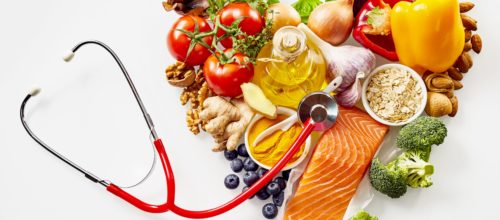
The DASH Diet
Hypertension is one risk factor for developing cardiovascular disease. Several factors can lead to the development of hypertension such as age, race, gender, family history, genetics, obesity, physical inactivity or diet. Although we are not in control of many of these factors, we are in total control of the foods we consume. The DASH diet is an eating plan that can be used to help to lower or control blood pressure.
The DASH diet can be followed by those with normal blood pressure, prehypertension or hypertension. DASH stands for a dietary approach to stop hypertension. This diet is low in saturated fat, total fat, and cholesterol. It recommends consuming a variety of fruits, vegetables, whole grains, and low-fat dairy products. You should also limit the intake of sweets, sugar-sweetened beverages, red meat and high sodium items such as fast food, potato chips, and processed foods. It is recommended that people following this diet keep their sodium intake under 2,300 mg per day.
Foods eaten in this diet are rich in magnesium, potassium, calcium, protein, and fiber. The nutrients in many of these foods are abundant in phytochemicals, such as polyphenols, antioxidants, and carotenoids. These nutrients can help to prevent kidney stones, cancer, and protect against heart disease. The DASH diet combined with exercise and weight loss can have a huge impact on blood pressure reduction. This diet shows us that dietary choices have just as much of an effect on controlling blood pressure as medications do.
DASH Diet Tips!
- Add a serving of vegetables at lunch and dinner.
- Add a serving of fruit to your meals or as a snack. Canned and dried fruits may be used, but make sure to check for added sugars.
- Use only half your typical serving of butter, margarine, or salad dressing. Use low-fat or fat-free condiments. Olive oil can also be replaced for butter or margarine. Olive oil is a source of monounsaturated fat, which is much healthier than trans and saturated fats that make up butter and margarine.
- Drink low-fat or skim dairy products any time you would normally use full-fat or cream.
- Limit meat to 6 ounces a day. Make some meals vegetarian.
- Instead of snacking on chips or sweets, eat unsalted pretzels, nuts, seeds, fruit, low-fat and fat-free yogurt, unsalted plain popcorn with no butter, and raw vegetables.
- Read food labels to choose products that are lower in sodium.
Reference:
Byrd-Bredbenner, C. (2019). Wardlaws perspectives in nutrition. New York, NY: McGraw-Hill Education.
